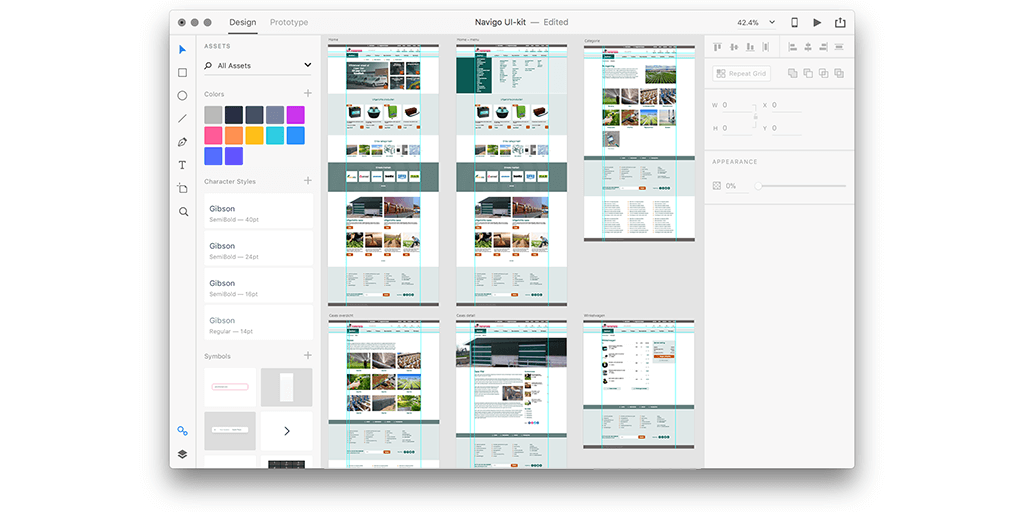In the digital age, where information overload is a real challenge, the concept of information architecture (IA) has become increasingly critical. Born from the crossroads of library sciences and web design in the late 20th century, IA helps in organizing, structuring, and labeling content effectively so that users can find exactly what they need without hassle. Whether it’s navigating a website or using an app, good IA makes the experience intuitive and straightforward.
Dive into how this backbone of user experience design not only enhances usability but also guides users through a seamless journey in the vast ocean of digital content.
- Understanding Information Architecture
- Importance and Impact on Business
- Principles and User-Centered Design
- Differentiating IA from UX and Sitemaps
- Content Organization and Labeling Strategies
- Types of Navigation and Tools Used
- Role of Information Architect and Key Processes
- Best Practices and Creating Effective IA in 9 Steps
- Summary
- Frequently Asked Questions
Understanding Information Architecture
Structure Significance
Information architecture defines how we organize and label digital platforms like websites. It’s the backbone of any online presence. By setting a clear structure, users find what they need without confusion.
A well-planned architecture breaks down complex information into digestible parts. Imagine a library without a catalog or sections. Finding a book would be frustrating, right? That’s why good information architecture matters.
Communication Clarity
It plays a crucial role in communication. Clear labels and organized content mean messages reach users effectively. When information is easy to access, it strengthens the connection between the site and its visitors.
Effective information architecture removes barriers to understanding. It ensures that whether someone is browsing for specific details or just exploring, they can easily grasp what you offer.
Enhanced Experience
Simplifying navigation boosts user experience significantly. Users stay longer on sites where finding information feels effortless. Think about your favorite website; its ease of use likely contributes to why you like it.
By guiding visitors smoothly from one section to another, information architecture makes websites more enjoyable to use.
Benefits include:
- Reduced frustration
- Increased engagement
- Higher satisfaction levels
Importance and Impact on Business
Website Usability
Information architecture is crucial for website usability. It makes sites easier to navigate. Users find what they need faster.
A well-structured site keeps users happy. Happy users are more likely to return. They also recommend the site to others.
Search Visibility
Good information architecture boosts search engine rankings. It does this by organizing content in a way that’s easy for search engines to understand.
This organization helps your site appear in relevant searches. More visibility leads to more traffic. And more traffic can mean more business.
User Engagement
Engagement and conversion rates soar with good information architecture. Users stay longer on sites that are easy to use.
They’re also more likely to complete desired actions, like making a purchase or signing up for a newsletter.
Principles and User-Centered Design
User Needs
Prioritizing users’ needs is crucial in organizing information effectively. By focusing on what users are looking for, the structure becomes more intuitive. This approach ensures that the website or app meets real-world demands.
For example, a retail website might organize products by category based on user shopping habits. This makes finding items faster and easier. Understanding these needs comes from direct feedback and observing how users interact with your platform.
Iterative Testing
Employing iterative testing refines information architecture (IA) based on user feedback. Initial designs undergo several rounds of usability testing with real users to identify pain points and areas for improvement.
This process might reveal that certain terms are confusing or some navigation paths lead to dead ends. Adjustments are then made to create a smoother experience. Iterative testing bridges the gap between initial design assumptions and actual user behavior.
Balancing Goals
Balancing business goals with user expectations achieves optimal results. While businesses may aim to promote certain products or services, it’s important not to compromise the usability of the site in doing so.
- Pros of balancing goals include increased user satisfaction and higher conversion rates.
- Cons could involve longer development times as adjustments are made to align both sets of goals.
A successful IA doesn’t just look good; it serves both parties efficiently by guiding users toward their objectives while supporting business strategies.
Differentiating IA from UX and Sitemaps
Content Structure
Information architecture (IA) focuses on organizing content in a way that makes sense. It’s about making information findable and understandable. Think of it as the blueprint of a building. Without it, you wouldn’t know where to place the rooms or how they connect.
On the other hand, user experience (UX) is broader. It covers all aspects of a user’s interaction with your product or service. This includes not just layout but also design, usability, and function. If IA is the blueprint, UX is how people feel walking through that building.
Site Visualization
Sitemaps are tools for visualizing site structure. They’re like maps showing each room in our metaphorical building.
However, creating an effective IA requires more than just drawing this map. It involves strategic planning about what content goes where and why it should be there in the first place.
This depth makes IA distinct from simply sketching out sitemaps.
Team Roles
Understanding these differences clarifies roles within project teams.
With clear distinctions between IA, UX, and sitemap creation, team members can focus their expertise more effectively.
- An IA specialist digs into content strategy.
- A UX designer ensures overall enjoyable interaction.
- Someone tasked with developing sitemaps might focus on logical flow without getting bogged down by deeper strategic concerns.
This specialization leads to better outcomes because everyone knows their part in creating an engaging user experience while ensuring content is both accessible and meaningful.
Content Organization and Labeling Strategies
Categories and Hierarchies
Creating a clear structure within a website involves organizing content into categories and hierarchies. This method helps users find what they need quickly. For instance, an online store might categorize items into ‘Men’, ‘Women’, and ‘Kids’ sections, each with sub-categories like ‘Clothing’, ‘Accessories’, and ‘Shoes’.
This setup guides users through the site’s offerings in an intuitive way. It mimics how we organize information in the real world, making digital navigation feel more natural.
Consistent Labeling
Using consistent labels across your site reduces confusion for visitors. If every section related to customer support is labeled as “Help”, users will know exactly where to click without second-guessing. This consistency extends to all aspects of information architecture, including menu items, buttons, and instructions.
Consistency helps build user trust because it creates a predictable environment. When everything is where users expect it to be, they’re more likely to use the site again.
Metadata Usage
Metadata plays a crucial role in enhancing search functionality on a website. By tagging content with relevant keywords behind the scenes, you make it easier for search engines—and by extension, your users—to find specific information quickly.
For example:
- A blog post about gardening could include metadata tags like ‘gardening tips’, ‘plant care’, or ‘outdoor plants’.
- An e-commerce product page might use tags such as ‘leather boots’, ‘waterproof footwear’, or ‘winter collection’.
Adopting metadata not only improves internal search results but also boosts SEO performance by helping search engines understand your content better.
Types of Navigation and Tools Used
Global Navigation
Global navigation acts as the backbone of information architecture. It guides users across the entire website or app from any page. Think of it as a map that shows all major destinations.
Users find global navigation helpful because it’s consistent and predictable. For instance, placing a menu bar at the top or side allows easy access to main sections like Home, About Us, and Contact.
Local Navigation
Local navigation dives deeper, showing paths within a section. It’s like zooming in on a neighborhood in our map analogy.
This type is crucial for exploring related content without going back to the global menu. A sidebar listing articles under “Recent Posts” on a blog is a good example. Users appreciate this focused guidance.
Contextual Navigation
Contextual navigation links directly relate to what’s being viewed or read. It offers specific suggestions, making user journeys smoother and more intuitive.
For example, links within an article recommending further reading are contextual cues guiding users based on their current interests.
Breadcrumbs
Breadcrumbs trace steps back to the start without using the main navigation system. They’re especially useful in complex websites with multiple layers.
They lay out paths clearly like: Home > Blog > Category > Post Title. Users rely on breadcrumbs for orientation without feeling lost.
Validation Tools
- Card Sorting: This method helps organize content intuitively by allowing users to group information into categories.
- Tree Testing: After designing the structure, tree testing checks if users can find items easily using only your site’s hierarchy.
Both tools validate whether your navigational schemes make sense from a user perspective before finalizing them.
Role of Information Architect and Key Processes
Business Objectives
An information architect translates business goals into a practical content structure. They start by understanding what the business wants to achieve. This could be increasing sales, improving customer satisfaction, or sharing knowledge.
They then design a content framework that makes these goals achievable. For example, if the goal is to improve customer service, the architect might create an easily navigable FAQ section.
User Research
Conducting user research is crucial for making informed architectural decisions. The information architect studies how users interact with the site. They look at what users search for and how they navigate through pages.
This research helps in creating a site structure that feels intuitive to the user. If previous sections discussed navigation tools, here we see their foundation laid out by understanding real user needs and behaviors.
Collaboration
The role doesn’t end with planning; collaboration is key. Information architects work closely with designers and developers to bring their plans to life. They ensure everyone understands the IA plan’s importance for user experience.
This teamwork ensures that the navigation tools mentioned earlier are implemented effectively within the designed architecture, providing a seamless experience for users.
Best Practices and Creating Effective IA in 9 Steps
Stakeholder Interviews
The first step in creating effective information architecture (IA) involves conducting thorough interviews with stakeholders. This process helps to understand the business goals clearly.
By talking to stakeholders, one can gather essential insights about what they expect from the website or app. These discussions are crucial for aligning the IA with business objectives. They ensure that every part of the structure serves a purpose towards achieving these goals.
Content Strategy
Before diving into designing structures, developing a clear content strategy is vital. This means deciding on what content will be included and how it will be organized.
A solid content strategy acts as a blueprint for the IA. It guides decisions on hierarchy and navigation based on user needs and business goals. Without this foundation, the architecture could become confusing or inefficient.
Iterative Testing
Iteratively testing with real users is key to refining the architecture. Feedback from actual users provides invaluable insights that can’t be predicted otherwise.
Through iterative usability testing, designers can identify issues early on. They adjust structures before finalizing them. This approach ensures that the end product is both usable and useful to its target audience.
Summary
Diving into the world of information architecture (IA) is like mastering the art of organizing chaos. You’ve seen how crucial it is for your business, to guide users effortlessly through a sea of information. By distinguishing IA from UX, understanding its principles, and exploring strategies for content organization, you’re now equipped to craft experiences that feel as natural as breathing. Remember, an effective IA doesn’t just happen—it’s carefully planned and executed with the user at heart.
Now it’s your turn to take the reins. Whether you’re tweaking an existing site or building a digital empire from scratch, remember the power of well-structured information. It’s not just about making things look pretty; it’s about creating a seamless journey for your users. So, roll up your sleeves and start sketching out your blueprint. Your audience is waiting for that flawless experience only you can provide. Let’s make the digital world a bit more navigable, one well-placed piece of information at a time.
Frequently Asked Questions
What is Information Architecture (IA)?
Information architecture (IA) is like the blueprint of a website or app. It’s all about organizing, structuring, and labeling content so users can find info easily and complete tasks efficiently.
Why is IA important for businesses?
Good IA makes your website user-friendly, boosting customer satisfaction and retention. Think of it as making sure customers don’t get lost in a digital maze but find exactly what they need swiftly.
How does IA differ from UX?
While IA focuses on organizing content logically, UX design encompasses the overall feel and operation of a product. Imagine IA as plotting out the chapters of a book, while UX ensures the entire reading experience is enjoyable.
Can you explain some principles of user-centered design in IA?
User-centered design in IA means putting your audience first; like ensuring your website’s navigation makes sense to them rather than just looking good on paper. It involves understanding their needs deeply before crafting your information structure.
What are some best practices for creating effective Information Architecture?
To create an effective IA, start by understanding your users’ needs, and then organize content logically. Use clear labels for easy navigation. Remember: keeping it simple often leads to the best user experience.
What role does an Information Architect play?
An Information Architect acts like a librarian for digital content. They sort, label, and organize information so that users can find what they’re looking for without breaking a sweat.





